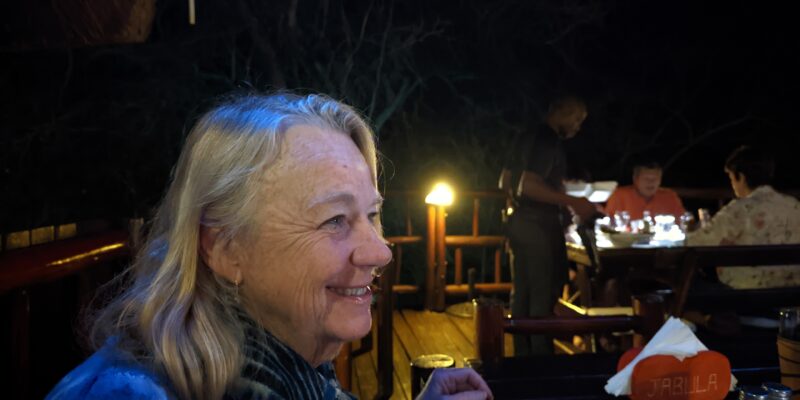
What a busy morning! At 6:00 am, Tom bolted out of bed to get ready to drive Connie back to Tonga for the final viewing. The mortician will drive Jeff’s remains to Nelspruit, and the ashes will be delivered to us tomorrow, Wednesday. This will be an emotional event.
Connie has a lot of paperwork to complete before they depart for the US this Friday, only three days from today. It’s hard to imagine that they will be gone. We’ve become closer than ever under these sorrowful circumstances. Once they depart, we’ll strive to return our lives to a familiar pace.
Of course, having almost completely recovered from the headache and facial pain, I am in a much better state of mind. It’s not as if I was down in the dumps during those painful months, but it undoubtedly impacted my quality of life. We went out for dinner; we socialized; we visited Kruger National Park, and we spent countless days and nights enjoying the visiting wildlife.
But, now, everything has changed, and I am glad I started to improve, after three weeks on the meds, to be present for our arriving guests ten days ago and the tragic loss that transpired last Wednesday, stretching well into the remaining time that Connie and Lindsey are spending here with us.
We all agreed to dine out the next three nights with load shedding continuing and high temperatures. We’ll spend their last night in the bush on Thursday at Jabula. They both love the food and atmosphere at the Cheers-like bar and wanted to spend one more evening there. Tom and I will still spend our usual Friday night at Jabula after Connie and Lindsey have left for the US.

Today, we’re heading to Ngwenya Lodge for sundowners at sunset and later dining indoors away from the flying insects we encountered last night. Last night, we had no choice but to come inside the house to eat at the dining room table when insects beyond any past experiences bombarded us. TIA…This is Africa…this is what happens here in the spring and the heat.
My desire to cook has waned considerably in the past few days. The number of flies that mysteriously appear in the kitchen while preparing a meal is in the dozens, longing to land on any meat they can. Yuck. Flies annoy me more than most other insects.
I suppose we will most likely dine out two or three times a week over the upcoming hot summer months to make life easier. We’ll cook on the cooler days, but on the 42C, 104F days, we will go out to dinner. I have no desire to prepare meals and leave Tom in the kitchen in the dark at night, during load shedding, trying to do the dishes using a battery-powered lantern. The warmer the temperatures, the more flies, join me in the kitchen.
Right now, Connie and Lindsey are visiting the little shops here in Marloth Park. Tom is on the veranda watching football on his laptop via NFL Game Pass. As soon as I am done here today, I may take a little break and lounge in the bedroom with the big fan running off of the inverter.
The house is clean, animals have returned to the garden after the holiday weekend, and we’re bracing ourselves for the influx of tourists who will be flooding Marloth Park, starting this weekend and continuing for ten days, due to the “school holiday,” which brings people to Marloth Park from all over the country and some from other countries. We’ll see less wildlife and hear more cars passing at the house and when out and about.
Thank you to many of our readers who’ve written to express their condolences. If we missed responding to you, please bear with us. We’ve had more responses than we could count.
Have a great day and evening!
Photo from one year ago today, September 27, 2021:

















